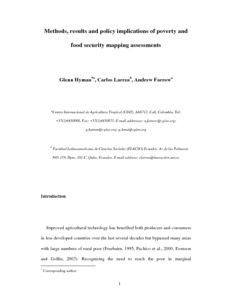Resource information
The importance of poverty reduction to the world development agenda has motivated greater interest in the geographic dimensions of poverty and food security. This special issue of Food Policy includes examples of poverty and food security mapping used to support policy development in agricultural and rural areas. The volume includes eight country case studies and one cross-country comparison that illustrate advances in our capacity to assess welfare over large areas and at detailed spatial resolutions. Poverty mapping facilitates assessments of the role of environmental factors on the broad spatial pattern of poverty and food security. Evaluating proximity and accessibility in welfare outcomes can improve our knowledge of poverty patterns and processes. Spatial statistics can enhance our understanding of geographic and neighbourhood effects on poverty and food security outcomes. The development of effective policies requires increased collaboration among stakeholders, researchers and policy makers in constructing and using poverty and food security maps.


